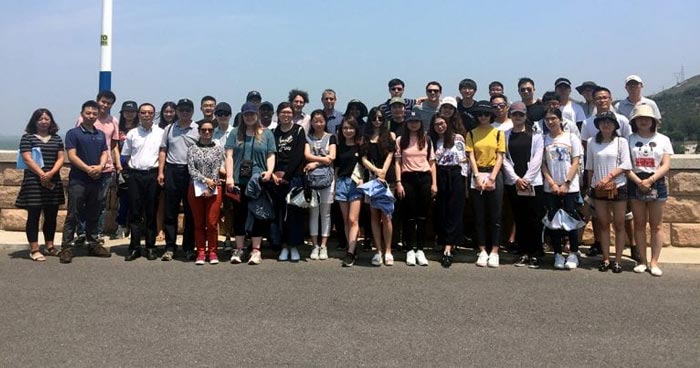In the field: water management in Yellow River Basin
It’s always wonderful to have the opportunity get out of the classroom and learn through doing, as a group of Melbourne School of Engineering students recently discovered through the intensive subject, ENEN90037: International River Basin Management (IRBM). Two PhD candidates from the Department of Infrastructure Engineering, Seema Karki and Lubna Meempatta, offered to share some of their experiences.

A recent two week intensive subject, ENE90037: International River Basin Management, provided a unique opportunity to develop greater knowledge of managing co-evolved river-basin systems through gaining practical experience in China’s Yellow River Basin.
Hosted by Beijing’s Tsinghua University, the 14 participating students were joined by the University of Melbourne’s Professor Michael Stewardson (Discipline Leader of Environmental Hydrology and Water Resources Group & IRBM Coordinator), Jong Lee (Director of Hydrology Applications for Murray-Darling Basin Authority) and Brenden Cossens (Senior Hydrogeologist for Goulburn-Murray Water).
After beginning with a theory-based class held at the University of Melbourne in the first week students headed to Yellow River Basin in Beijing for the following week, conducting a number of visits to different sites around the region.

By Shannon1 – Created using Natural Earth and NASA SRTM data, both public domain., CC BY-SA 4.0
During the field trip the team travelled approximately 2500 km through the Yellow River Basin, visiting key institutions and water structures along the way. Starting at Tshingua University, where Professor Zhong Jing Wang provided a briefing, participants first visited the Guanting Reservoir, located at the upper reaches of the Yongding River. The largest river flowing through Beijing, the Yongding is a main tributary of the Hai river system, with Guanting Reservoir supplying water for a range of irrigation and industrial uses. Due to issues with poor water quality, the reservoir stopped supplying drinking water in 1997.

Representatives from the University of Melbourne, Murray-Darling Basin, Tsinghua University and students in front of Guanting Reservoir
Three subsequent visits yielded interesting insights into various aspects of water management. A visit to Shiqinli Hydrologic station explained the process of monitoring hydrologic information in catchments; at Rubicorn Irrigation Area participants were taught about integration of modern irrigation technology with traditional irrigation systems; and at the Hebei Irrigation Area students received an account of the measures adopted to reduce ground water usage through increasing water prices and improving surface water supply.
Other highlights during the trip included the Hukou Waterfall which impacts the Yellow River Basin by carrying and transporting high amounts of sediments, the Sanmexia Dam which was constructed to control sedimentation in the river, and the group’s visit to Huang Wei Water Centre, the Yellow River Conservancy Commission headquarters, who are authorised by the Ministry of Water Resources to oversee water administration in the Basin.

South-to-North Water Diversion Channel; 1500 Km long with a capacity of approximately 20,000 ML/day (by Seema Karki)
A visit to the South-to-North Water Diversion Channel generated a large amount of active discussion among students about whether the construction of such large-scale projects would be possible in Australia and led to continued conversations comparing Australia’s and China’s approaches to water management systems.
A presentation from the students incorporating the elements learned from the field and the background theory concluded the trip. Overall the hospitality and insights provided by the Tsinghua University team were outstanding, with everyone attending the trip grateful for the valuable experience provided to them through this tour.
This article was originally published on 5 September 2018.
Related topics